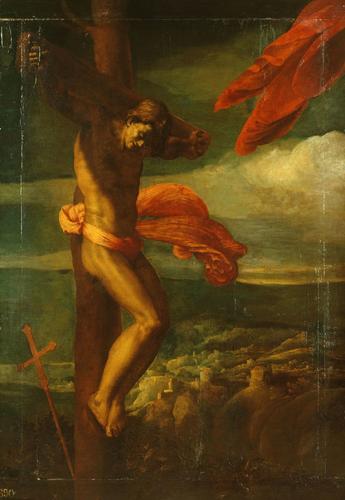-
1 of 253523 objects
A Fragment: The Good Thief (Saint Dismas) c. 1520-25
Oil on poplar | 122.6 x 84.6 x 3.0 cm (support, canvas/panel/stretcher external) | RCIN 402869
-
This painting and the fragment showing the Bad Thief are the only surviving fragments of an altarpiece showing the Deposition of Christ which was painted for the church of Santa Maria sopra Minerva in Rome. The altarpiece was damaged by a flood 8 October 1530 and dismembered by 1600. The missing sections showed Christ lowered from the cross by grieving apostles, two of whom are visible in the Bad Thief panel.
This was one of Perino's first commissions in Rome. It has been suggested that the altarpiece was painted to decorate the chapel in Santa Maria sopra Minerva, commissioned by Giovanni Battista Branconio dell' Aquila (who died in 1522) to house the remains of his brother, Benedetto, and demolished when the choir was remodelled in c. 1536-40. In its original position (above the altar of a chapel on the left-hand side of the choir) the direction of the light within the painting would have been consistent with that of the church, and the orientation of the body of Christ would have related to the high altar of the church. The panels are vividly described by Vasari in his life of the artist:
'the figures that he painted most divinely were those of the two Thieves, left fixed upon the crosses, which, besides appearing to be real dead bodies, reveal a very good mastery over muscles and nerves, which this occasion enabled him to display; wherefore, to the eyes of him who beholds them, their limbs present themselves all drawn in that violent death by the nerves, and the muscles by the nails and cords. There is, in addition, a landscape wrapped in darkness, counterfeited with much judgement and art. And if the inundation which came upon Rome after the sack [in October 1530] had not done damage to this work, covering more than half of it, its excellence would be clearly seen; but the water so softened the gesso and caused the wood to swell in such sort, that all the lower part that was soaked has peeled off too much for the picture to give any pleasure; nay it is a grief and a truly heartrending sorrow to behold it, for it would certainly have been one of the most prestigious things in all Rome.'
Something of the original appearance of this destroyed altarpiece can be reconstructed from surviving drawings: the two fragments would have hung with Christ's cross between them, and grieving apostles below. (St Peter and John the Evangelist can still be seen below the Bad Thief).
Catalogue entry adapted from The Art of Italy in the Royal Collection: Renaissance and Baroque, London, 2007Provenance
Acquired by Charles I; recorded in the Long Gallery at Whitehall in 1639 (no 34); sold from Somerset House as a pair for £40 to John Stone and others on 23 October 1651 (no 99); recovered at the Restoration and listed in the Room between the Long Gallery and the Withdrawing Room at Whitehall in 1666 (no 83)
-
Medium and techniques
Oil on poplar
Measurements
122.6 x 84.6 x 3.0 cm (support, canvas/panel/stretcher external)
140.3 x 102.7 x 7.0 cm (frame, external)
Other number(s)
Alternative title(s)
The repentant thief

